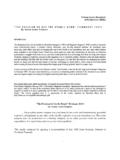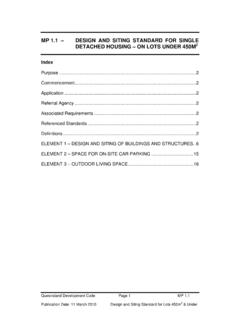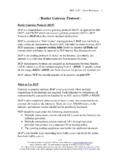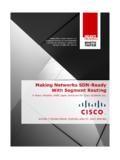Transcription of Configuring Route Maps and Policy-Based Routing
1 C H A P T E R2 Configuring Route Maps and Policy-Based RoutingPerhaps one of the most colorful descriptions for Route maps is that Route maps are like duct tape for the network not necessarily because they can be used to fix or mend something broken, but because they can be applied to numerous situations to address many issues. At times, they may not be the most pretty solutions, but they will be very effective. After you learn to configure and use Route maps, you will soon see why some engineers refer to them as Route tape. In Policy-Based Routing (PBR), for instance, you may use a Route map when traffic has to follow a particular path through the internetwork. This path may differ from the path the Routing protocol wants to forward traffic on. PBR, along with Route maps, enables the network engineer to essentially override the Route table and influence which way traffic flows. You also can apply Route maps in a number of ways. The following list contains some of the more common and powerful applications of Route maps: Route filtering during redistribution between Routing protocols Route control and attribute modification on BGP neighbors Route metric modification or tagging during redistribution between Routing protocols Policy-Based Routing (PBR)After you have Route maps in your engineering tool kit, you will have one of the most powerful and versatile configuration options available on Cisco routers.
2 This chapter discusses how to configure and use Route maps and how to configure Map OverviewRoute maps are much like the If .. Then .. statements of many programming languages. If a certain condition is true, then do something. Route maps enable you to define Routing policy that will be considered before the router examines its forwarding table; therefore, you can define Routing policy that takes precedence over the different Route processes. This is why Route maps are some of the most powerful commands you can use on a router. Example 2-1 highlights Route map Page 147 Friday, October 10, 2003 9:49 AM148 Chapter 2: Configuring Route Maps and Policy-Based RoutingIn a nutshell, Route maps work in the following manner: 1 Essentially, a process whether it is a redistribution process, policy Routing , or some other process such as Network Address Translation (NAT) calls a Route map by a text- based name. 2 The Route map, in turn, has conditions or match statements, which are usually, but not always, an access list or extended access list.
3 Border Gateway Protocol (BGP), for instance, can match on an autonomous system number (ASN) or different attributes. The match statement(s) can be followed by set statements. If the match statement returns a true result, the set statement(s) are executed. Example 2-2 shows how a Route map functions during 2-1 Route Map Logic Route -map route_map_name permit 10 match criteria_1 set perform_action_1route-map Route -map_name permit 20 match criteria_2 set perform_action_2 set perform_action_3route-map Route -map_name permit 30 match criteria_3 criteria_4 criteria_5 set perform_action_2 set perform_action_4 set perform_action_5route-map Route -map_name deny 65536 implicit deny at the end match everythingExample 2-2 Route Map Function During Redistribution router ospf 2001 redistribute eigrp 65001 subnets Route -map route_map_name Call the Route -map and send EIGRP routes for comparison! Route -map route_map_name permit 10 Route -map with the lowest sequence number gets executed first match ip address access_list Call access-list, the IF of the Route -map set condition If access-list is true, THEN do something!
4 Route -map route_map_name permit 20 Next highest sequence number gets executed match ip address access_list Call access-list, the IF of the Route -map set condition If access-list is true, THEN do something! Route -map route_map_name deny 65536 Implicit deny at the end all Route -maps match ip address all_routes This will not show up in the Page 148 Friday, October 10, 2003 9:49 AMRoute Map Overview 149 The next example is the syntax of an actual Route map. Example 2-3 demonstrates how a Route map can be applied during the preceding example, a Route map is used to control and tag the routes from Enhanced Interior Gateway Routing Protocol (EIGRP) when they are redistributed into Open Shortest Path First (OSPF). During the OSPF redistribution process, a Route map titled set_tag is called. The Route map consists of three parts. The first part calls access control list (ACL) 10, which will permit the network and set a tag of 10.
5 The second part calls ACL 11, which in turn matches IP address If a match occurs, the metric will be set such that when the Route is redistributed, it becomes an OSPF type 1 Route ; finally, the tag will be set to 11. The last part of the Route map doesn t call an ACL, so all routes are matched, and the set condition is applied. In this example, the router is setting the tag to 300. You can set tags in this manner to help document the network, or you can use the tags to identify routes that you may want to filter or perform some other action on. Route maps have the following common characteristics: Route maps are executed in the order of the lowest sequence number to the highest. You can edit or modify maps by using the sequence number. If a match is found within a Route map instance, execution of further Route map instances 2-3 Route Map Application During Redistribution router ospf 65 log-adjacency-changes log-adjacency-changes redistribute eigrp 65001 subnets Route -map set_tag Call the Route -map "set_tag" network area 0 default-metric 10!
6 Access-list 10 permit Match the subnetaccess-list 11 permit Match the subnet! Route -map set_tag permit 100 Route -map "set_tag" match ip address 10 Call access-list 10, if this is true set tag 10 If access-list is true set the tag of 10! Route -map set_tag permit 200 If no match above, try and match the following: match ip address 11 access list 11 set metric-type type-1 If the ACL is true, set the OSPF metric type to 1 set tag 11 and set a tag of 11! Route -map set_tag permit 300 set tag 300 All other routes get a tag of 300! Page 149 Friday, October 10, 2003 9:49 AM150 Chapter 2: Configuring Route Maps and Policy-Based Routing You can use Route maps to permit or deny the information found true by the match statements. If multiple match statements are called within a single Route map instance, all match statements must match for the Route map instance to yield a true result.
7 If Route maps are applied in a policy - Routing environment, packets that do not meet the match criteria are then forwarded according to the Route table. If there is no match statement in the Route map instance, all routes and packets are matched. The set statement will apply to all routes or packets. If there is not a corresponding ACL to the match statement in the Route map instance, all routes are matched. The set statement, in turn, applies to all routes. As with ACLs, an implicit deny is included at the end of the Route map policy . You can use Route maps to create policies based on the following: IP address End-system ID Application Protocol Packet sizeConfiguring Route MapsThe Route map syntax is composed of roughly three separate Cisco commands, depending on what the Route map is accomplishing and what type of process is calling it. This discussion covers the following commands in detail as Route maps are configured throughout this chapter: Route -map commands match commands set commandsWhen configuring Route maps, you can follow a basic five-step configuration process.
8 Depending on the Route map application, additional configuration may be needed, such as with BGP communities or 1(Optional) Configure any ACLs, AS_PATH list, or any other match criteria that the Route map may be using on the match commands. This should be done first, so you do not call an empty ACL or AS-PATH 2 Configure the Route map instance. This is accomplished with the Route -map name permit | deny sequence_number command. Be sure to leave room in between the sequence numbers for future updates or modifications. The Route map instance with the lowest sequence number is executed first. Page 150 Friday, October 10, 2003 9:49 AMRoute Map Overview 151 Step 3 Define the match criteria and configure the match statements that will be used in this single Route map instance. You do this with the Route map configuration match command. In the absence of any match commands, all packets or routes are 4(Optional) Define the set criteria and configure the set statements that will be used in this single Route map instance.
9 You can do so with the Route map configuration set 5(Optional) Configure any ACLs, AS_PATH list, or any other match criteria that the Route map may be using on the match 6 Apply the Route map. Once again, depending on the Route map application, it can be applied in many ways. Some of the more common applications include Route redistribution, PBR, and this configuration process in mind, we will discuss in more detail the three primary commands used to configure Route CommandsThe complete syntax for the Route -map command is as follows: Route -map route_map_name [permit_|_deny][sequence_number_1-65535] The route_map_name, also called the map tag, is the text- based name of the Route map. The name is unique and logically groups and defines the entire Route map policy . This is the name that you use to call the Route map during redistribution and other processes. The permit and deny keywords are optional; the default keyword is permit. If the Route map is called from a redistribution process, the keyword is set to permit, and the match criteria are met for the Route map, the Route (s) are redistributed.
10 If the keyword were set to deny, in the same scenario the Route (s) would be denied. If the Route map is called from a policy - Routing statement, the match criteria are met for the Route map, and the keyword is set to permit, the packet would be policy routed. Once again, permit is the default keyword. If the deny keyword is used, the packet is forwarded according to the normal Route sequence-number indicates in what order the Route map statements will be executed. When a Route map is called, the Route map with the lowest sequence number is executed first. If a match is not found in the Route map with the lowest sequence number, the Route map with the next highest sequence number is executed. This process repeats itself until a match is found or no more Route map statements exist. If a match is found, execution for that individual packet or Route stops, and the next packet or Route begins the process again starting with the Route -map statement with the lowest sequence number.
















